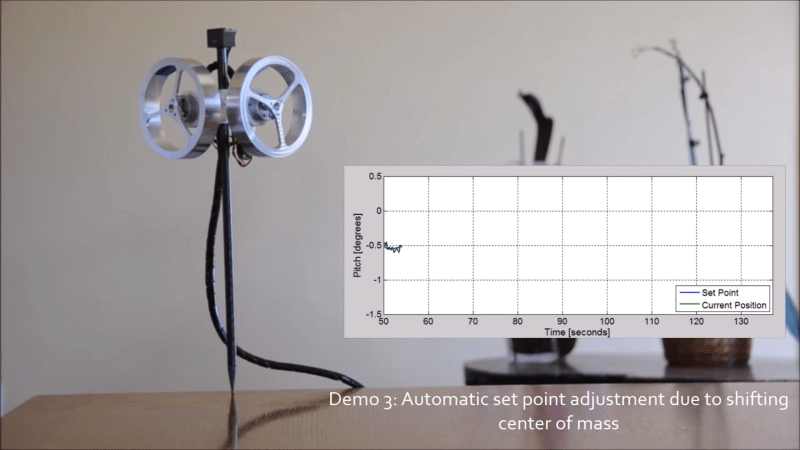The inverted pendulum is a pretty classic dynamics problem and reaction wheels are cool. That’s why we like [Mike Rouleau]’s self-balancing stick.
The video, viewable after the break, was fairly sparse on details, but he furnished some in the comments. The little black box on the top is a GY-521 Gyroscope module. It sends its data to an Arduino attached to the black cord which trails off the screen. The Arduino does its mathemagic and then uses a motor controller to drive the reaction wheels at the correct speeds.
[Mike] mentions that he didn’t do anything too fancy with the dynamic model of the demonstration. He even hand-tuned the PID values rather than resorting to fancier training methods. The Arduino simply runs a bit of code, and, optionally, streams some data back to the computer for visualization.
The stick can stay up until the power goes out, and is a pretty cool demonstration. As some mentioned in the comments; this would make a fetching desk ornament.
















Oooo. Shiny.
I want to equip my walking cane with this.
dagnab, was thinking months ago about how to make a self-stabilizing cane… this… had not occurred to me.
Looks like you’ve got another idea to work from now. If you do happen to make one, please let me know.
Think you could get enough juice through an induction charger to have it charge up some batteries and keep the reaction wheels going?
Put a wireless charging pad on the floor near your favorite seats and charge it up wirelessly while it’s standing.
I’ve got a “zap cane” that charges through a simple 1/8″ headphone jack. That’s a good way to avoid the losses of an induction charger, though keeping it topped off without having to plug in might be nice for a self-stabilizing cane, as it would be in use much of the time.
I’m imagining a cane hook with a charging coil built in, or even just a pair of contacts.
I’m sure someone smarter than me (almost everyone) will figure this out someday.
I feel like Gandalf did that in LOTR.
And this is why we like PID.
There is no PID in this project. All of the control was done with state-space methods as a class project.
You are wrong. It does use a modified PID controller and it had nothing to do with a class. It was a fun side project. Source: https://www.youtube.com/channel/UC02J9w1VZXXIjvq1R7RxBdA/discussion?lc=z13hi1iqeun5hrhgn04cdffxryr1jpmyg4k
Ha ha. Mike R, it looks like you have an evil doppelganger who only tells lies. The R stands for “Real” Mike.
Parts required and circuit diagram
Same principle as the Cubli I guess. Or courses the Cubli doesn’t use PID but something more complex.
Sorry, forgot the video link.
Here it is: http://m.youtube.com/watch?v=n_6p-1J551Y
Very cool.
I said that while watching the Women’s Gymnastics on the Olympics.
This makes me thing of a “Pogo Stick” robot, balance on one leg, lean towards your direction of travel, reorient leg in air, land, rebalance, repeat.
Jump after lean.
In college we had exercise similar to this, little less complicated. It was a stick balancing on single motor. Is this device purely for education purposes or there is practical use for this ?
What would happen if you put two sticks one on top of the other?
What are the blue patches inside the wheels good for?
I think it was to balance the wheels.
Prevents excessive vibration and is a good visual marker.
I hear some noise. Can you modulate music? …Dancing stick.
Massive potential if you sell this to drunk people in the form of a hat so they can walk home at night.
The power source required to run reaction wheels to stabilize a drunk human would be scary. The speeds of the reaction wheels would probably be even scarier :D
It would be alcohol powered of course! “One for me, one for you, one for me, one for you…”
Only scary when you’re sober…
How does the automatic set point adjustment work? An additional control loop acting as to keep the angular velocity at zero?
The funny thing about demos is that people (even people who know better) are going to get hung up on that wire. In my opinion, the next step would be to untether it and run it entirely off batteries and put the Arduino on board. It would get a bit bigger, but the effect would be so much more impressive (even if it really shouldn’t be).
I want to do two things.
i) Turn it into a trojan for segways so they’re balancing on their handlebars when the owners com back to them, much lolz very amuse.
ii) try it on a really really tall stick.
I LOL on that Segway idea!
Bravo!!
Kudos!
I wonder if you left such a device running long enough, could you infer the rotation of the Earth?